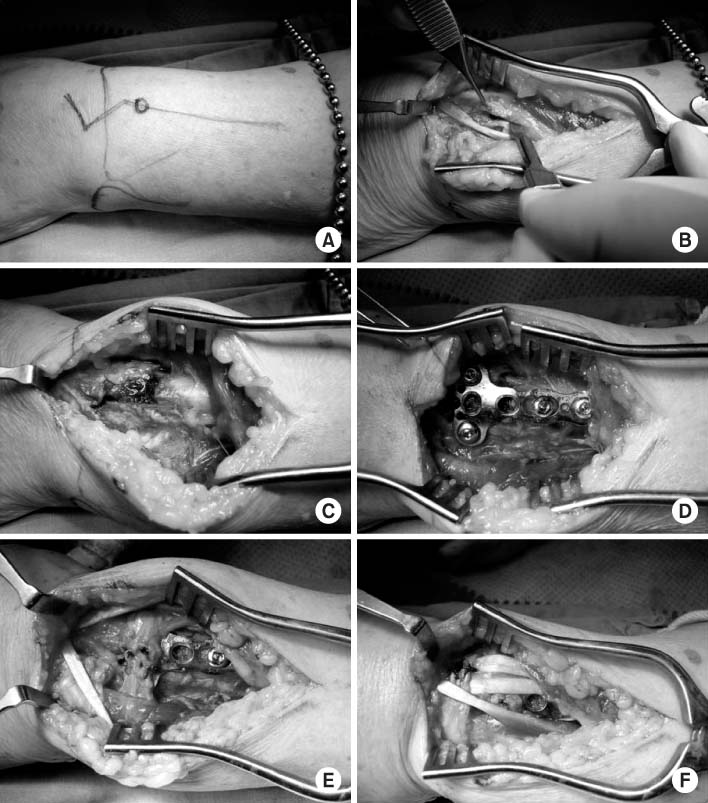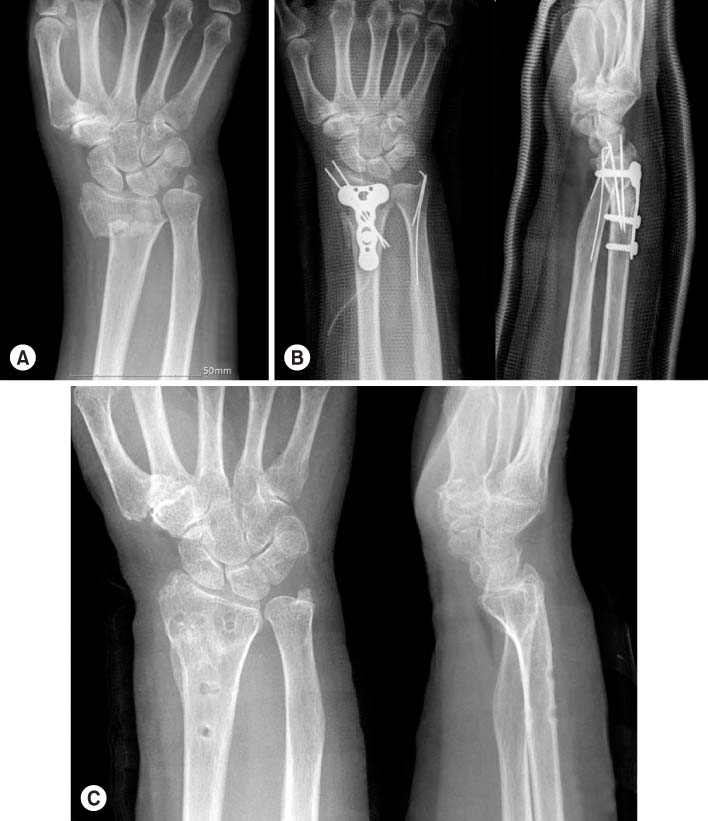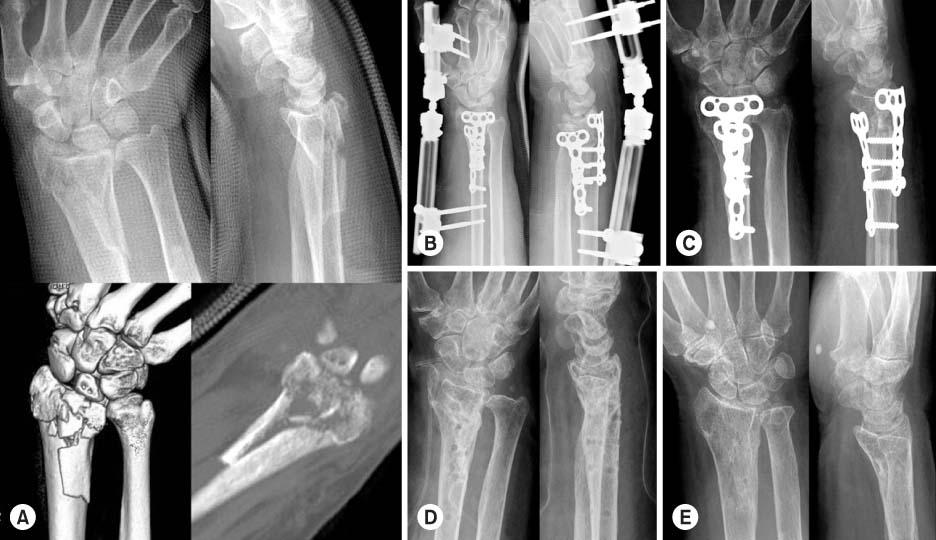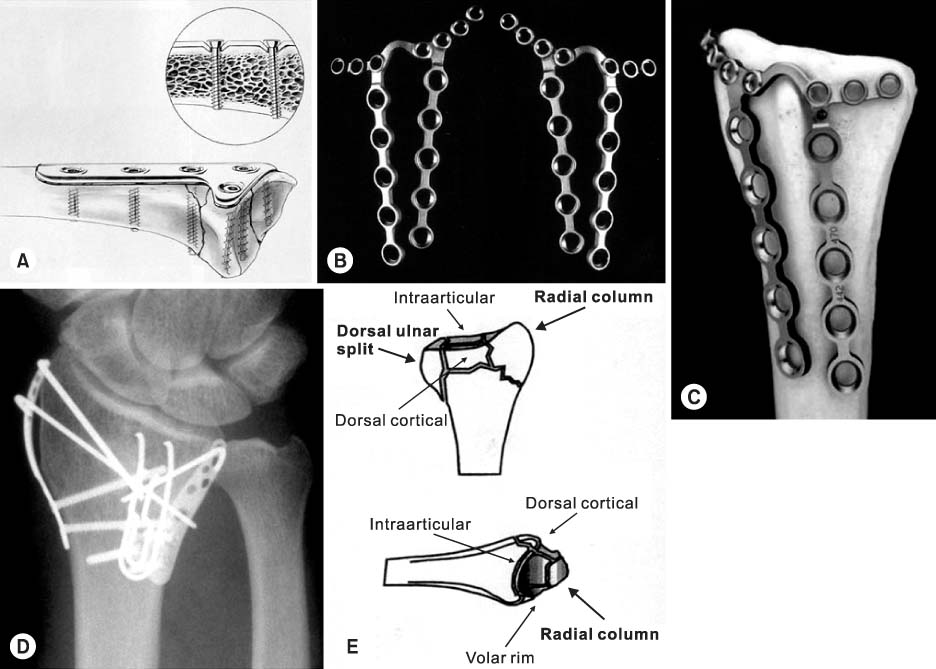J Korean Fract Soc.
2008 Oct;21(4):334-340. 10.12671/jkfs.2008.21.4.334.
Dorsal Plating for Distal Radius Fracture
- Affiliations
-
- 1Department of Orthopedic Surgery, St Mary's Hospital, Seoul, Korea. sw.song@catholic.ac.kr
- KMID: 1480925
- DOI: http://doi.org/10.12671/jkfs.2008.21.4.334
Abstract
- No abstract available.
MeSH Terms
Figure
Cited by 1 articles
-
Anatomical Reduction with Brick-Work Technique in Comminuted Intraarticular Distal Radius Fractures
Hyoung Min Kim, Hyung Lae Cho, Jong Woo Chae, Myung Ji Shin
J Korean Fract Soc. 2018;31(1):1-8. doi: 10.12671/jkfs.2018.31.1.1.
Reference
-
1. Axelrod TS, McMurtry RY. Open reduction and internal fixation of comminuted, intraarticular fractures of the distal radius. J Hand Surg Am. 1999; 15:1–11.
Article2. Bell JS, Wollstein R, Citron ND. Rupture of flexor pollicis longus tendon: a complication of volar plating of the distal radius. J Bone Joint Surg Br. 1998; 80:225–226.3. Carter PR, Frederick HA, Laseter GF. Open reduction and internal fixation of unstable distal radius fractures with a low-profile plate: a multicenter study of 73 fractures. J Hand Surg Am. 1998; 23:300–307.
Article4. Cross AW, Schmidt CC. Flexor tendon injuries following locked volar plating of distal radius fractures. J Hand Surg Am. 2008; 33:164–167.
Article5. Dao KD, Venn-Watson E, Shin AY. Radial artery pseudoaneurysm complication from use of AO/ASIF volar distal radius plate: a case report. J Hand Surg Am. 2001; 26:448–453.
Article6. Douthit JD. Volar plating of the dorsally comminuted fractures of the distal radius: a 6-year study. Am J Orthop. 2005; 34:140–147.7. Finsen V, Aasheim T. Initial experience with Forte plate for dorsally displaced distal radius fractures. Injury. 2000; 31:445–448.
Article8. Fitoussi F, Ip WY, Chow SP. Treatment of displaced intra-articular fractures of the distal end of the radius with plates. J Bone Joint Surg Am. 1997; 79:1303–1312.
Article9. Hahnloser D, Platz A, Amgwerd M, Trentz O. Internal fixation of distal radius fractures with dorsal dislocation: pi-plate or two 1/4 tube plates? A prospective randomized study. J Trauma. 1999; 47:760–765.
Article10. Herron M, Faraj A, Craigen MA. Dorsal plating for displaced intra-articular fractures of the distal radius. Injury. 2003; 34:497–502.
Article11. Hove LM, Nilsen PT, Furnes O, Oulie HE, Solheim E, Mölster AO. Open reduction and internal fixation of displaced intraarticular fractures of the distal radius. 31 patients followed for 3~7 years. Acta Orthop Scand. 1997; 68:59–63.
Article12. Kambouroglou GK, Axelrod TS. Complications of the AO/ASIF titanium distal radius plate system (pi plate) in internal fixation of the distal radius: a brief report. J Hand Surg Am. 1998; 23:737–741.
Article13. Keating JF, Court-Brown CM, McQueen MM. Internal fixation of volar-displaced distal radius fractures. J Bone Joint Surg Br. 1994; 76:401–405.14. Lowry KJ, Gainor BJ, Hoskins JS. Extensor tendon rupture secondary to the AO/ASIF titanium distal radius plate without associated plate failure: a case report. Am J Orthop. 2000; 29:789–791.15. Musgrave DS, Idler RS. Volar fixation of dorsally displaced distal radius fractures using 2.4-mm locking compression plates. J Hand Surg Am. 2005; 30:743–749.
Article16. Nunley JA, Rowan PR. Delayed rupture of the flexor pollicis longus tendon after inappropriate placement of the pi plate on the volar surface of the distal radius. J Hand Surg Am. 1999; 24:1279–1280.
Article17. Orbay JL. The treatment of unstable distal radius fractures with volar fixation. Hand Surg. 2000; 5:103–112.
Article18. Orbay JL, Touhami A. Current concepts in volar fixedangle fixation of unstable distal radius fractures. Clin Orthop Relat Res. 2006; 445:58–67.
Article19. Osada D, Viegas SF, Shah MA, Morris RP, Patterson RM. Comparison of different distal radius dorsal and volar fracture fixation plates: a biomechanical study. J Hand Surg Am. 2003; 28:94–104.
Article20. Peine R, Rikli DA, Hoffmann R, Duda G, Regazzoni P. Comparison of three different plating techniques for the dorsum of the distal radius: a biomechanical study. J Hand Surg Am. 2000; 25:29–33.
Article21. Ring D, Jupiter JB, Brennwald J, Büchler U, Hastings H Jr. Prospective multicenter trial of a plate for dorsal fixation of distal radius fractures. J Hand Surg Am. 1997; 22:777–784.
Article22. Schnur DP, Chang B. Extensor tendon rupture after internal fixation of a distal radius fracture using a dorsally placed AO/ASIF titanium pi plate. Arbeitsgemeinschaft für Osteosynthesefragen/Association for the Study of Internal Fixation. Ann Plast Surg. 2000; 44:564–566.
Article23. Suckel A, Spies S, Münst P. Dorsal (AO/ASIF) pi-plate osteosynthesis in the treatment of distal intraarticular radius fractures. J Hand Surg Br. 2006; 31:673–679.
Article24. Tavakolian JD, Jupoiter JB. Dorsal plating for distal radius fractures. Hand Clin. 2005; 21:341–346.
Article
- Full Text Links
- Actions
-
Cited
- CITED
-
- Close
- Share
- Similar articles
-
- Volar Plating of Distal Radius Fractures
- Dorsal Approach for Distal Radius Fractures
- Delayed Rupture of Flexor Pollicis Longus after Volar Plating for a Distal Radius Fracture
- Volar Dislocation of the Distal Radioulnar Joint Blocked by Displaced Dorsal Barton Fracture
- Complications of Distal Radius Fracture






